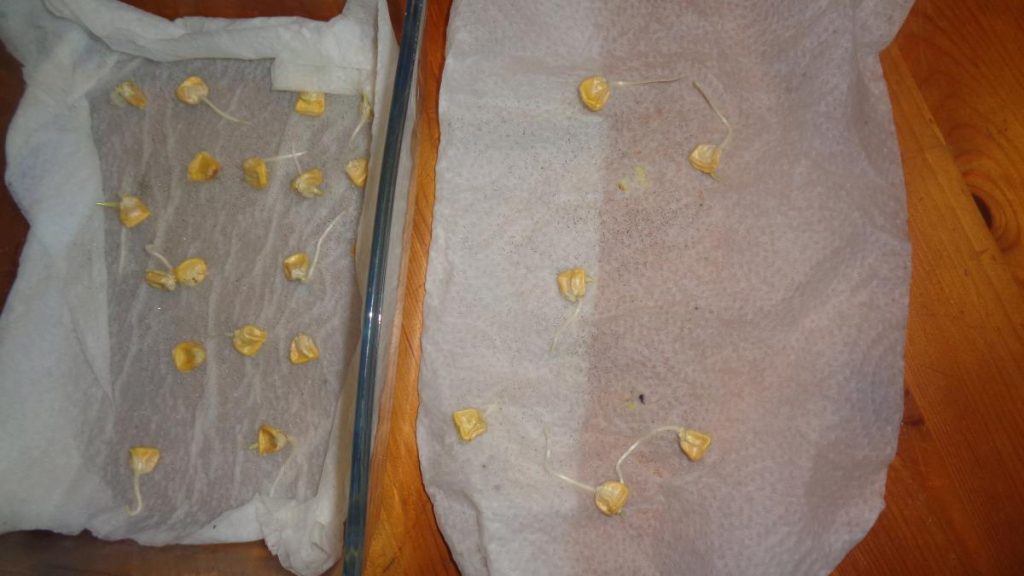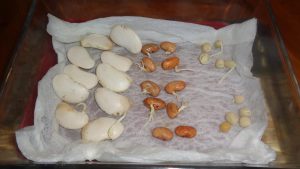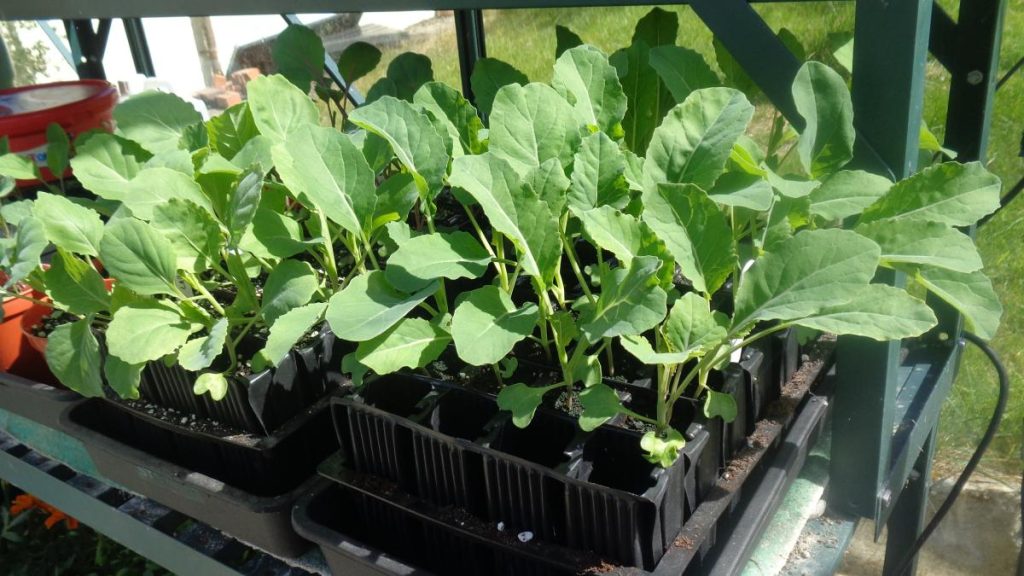Finally, at last, the weather has changed. Blue skies, sunshine and warm enough at points to not need a jacket. Now the race to catch up with jobs that should have been done weeks ago begins. Beds being cleared, sowing and planting and grass being cut – feels like we’re gardening again.
Sweetcorn Pot of Gold, chitted. It’s now been sown into 9cm pots under gentle heat and will go into the polytunnel. There may be some plants over which I’ll try outside although the wind here doesn’t like sweetcorn.
Germination test
Tested Gigantes runner beans, Borlotti beans and sugar snap peas. They were soaked in tepid water for an hour before being layered between sheets of damp kitchen roll. Did ten of each and the results were (drum roll):
- Borlotti Beans – 8 germinated which is pleasing.
- Peas – 6 germinated. Disappointing considering they’re supposed to be in date. My first sowing of these had been spotty, hence the test.
- Gigantes – 3 germinated. This is interesting as they were purchased as culinary beans, not seed. And they weren’t particularly fresh, either.
I did a quick, rough calculation – ignoring delivery costs. They’re expensive seeds to buy, 20 seeds running around £5.00. I’d expect 80% to come up so each plant would cost roughly 30p. 20 seeds weigh around 45 grams, call it 50 for ease of working.
A half kilo (500 grams) pack of the beans for the pot would cost around £5.00 and contain say 200 seeds. With 30% germination that would be 60 plants, roughly 8p per plant. However, those cheap plants involve a lot of waste and messing about to determine which seeds were going to germinate.
It may make economic sense to use culinary beans but I’ll stick to to specific seed and save some seed at the end of this season. I know, it’s not logical.
Raised Beds
The plan was to set up raised beds in the walled vegetable plot but that didn’t happen. The soil is deep and excellent in there now after the addition of masses of manure and compost. But raised beds will make it easier for me to handle things.
So some quick and rough repairs to the raised beds in the field plot which are going to be back in production this year. Cleared the woodchip mulch and weeded before feeding the beds and running the Mantis over to mix and loosen the soil.
Potatoes Planted
Planted Axona and Orla in the raised beds in the field plot. The recently bought Estima are still chitting in the shed.
Leeks
The leeks are doing well in the Bustaseed modules. I’m going to start feeding them with half strength S-Chelate 12-Star as the nutrients in the compost will run out shortly. Might have to re-locate them to the polytunnel as there’s competition for the bench space.
More Strawberries
Ordered 12 bare root strawberries from Dobies. Bit of an impulse purchase I tagged on to an order for some blueberries. They’re a late season variety strawberry, Florence. The plants arrived in good condition but very dry so popped into a bucket of water overnight. This rehydrated them and they were visibly happier the next day when planted out into hanging baskets.
There were more like 18 plants than 12, so great value for money. Especially compared with the Ebay seller who sent 19 plants instead of 20.
Blueberries
Dobies had an offer on blueberry plants in 1.5 litre pots, so ordered 5 to go onto the patio. I’ve been intending to get some blueberries for the last ten years, prompted by fond memories of my Grandmother’s blueberry pies – if only I knew how she made the delicious pastry. Better late than never I suppose.
I’ve got two Osorno, described by Dobies as “Early to mid-season variety (July). Vigorous, highly productive variety that is popular with commercial growers. Medium-sized, light blue fruit with good flavour and firmness. Very heat tolerant.”
Not sure about the value of “very heat tolerant” here up a hill in North Wales, but you never know!
Two Bluegold, “Mid to late season (late July- August). High-yielding, vigorous, upright bush bearing large clusters of dark blue, medium-sized berries. Very sweet flavour and a good shelf life. Golden autumn foliage and yellow stems. “
And finally, one Draper, “Mid to late season (late July to mid-August). Another popular commercial variety. Very large, medium-blue, firm fruit with a longer shelf life. Upright, branching growth. Good winter hardiness and late to flower, so buds are less susceptible to frost damage.”
Once they’ve grown on in pots for a year I’ll set up an acid bed as a permanent home for them. It will need to be fairly large as ideally they need to be spaced about five feet apart.
Cabbage & Cauliflower Rootrainers
I usually start my cabbages, cauliflowers etc. in a seed tray and then prick out into 9cm pots to grow on for planting out. It works well for me but the pots do take up space. I tried something different recently and pricked out into deep root trainers.
The results have surprised me – they’re actually doing better than they do in pots. Less space, less compost and easier to plant out with better plants. Wish I tried this years ago.







Leave a Comment Here on Chitting, germination test, blueberries, strawberries